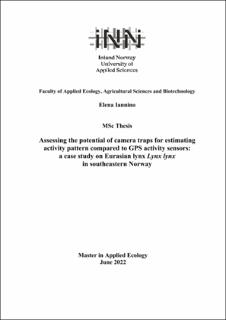| dc.description.abstract | Animals tend to have predictable activity patterns, based on their ecological and physiological needs, alternating between periods of activity and resting. Investigating factors influencing activity patterns for different species or populations can convey an understanding of physiology, niche theory, community structure and animal behaviour. The study of activity patterns of wild species is often challenging in the field, recent developments in technology have led to different methods being applied that can vary in the degree of invasiveness towards animal’s welfare and the financial and logistical efforts required to operate them. The gold-standard approach for quantifying the detailed movements and activity patterns of wildlife is through the use of Global Positioning System (GPS) collars and respective activity sensors. Most recently, the development of digital camera traps, that allow detection and monitoring of elusive wildlife while being non-intrusive and implementable over large areas, have become a new potential tool for estimating activity patterns. Nevertheless, there are still few studies that compare activity measurements obtained from camera traps data to those obtained from motion sensors/accelerometer data of GPS collars. The present study aims to examine the differences that might occur between data from animal mounted activity sensors and data from camera traps, assessing the accuracy of camera traps’ activity pattern estimation compared to the pattern resulting from GPS collar activity sensors. I therefore compared activity pattern estimation and circular datasets obtained from GPS collar accelerometers from 18 Eurasian lynx (8 females and 10 males) monitored during an 8 year study period (from 2008 to 2015) in the southern part of Norway and data from Eurasian lynx detections recorded from more than 300 camera traps distributed in the same area during a period of 11 years (from 2010 to 2020). My study results suggest that: 1) Accelerometer and activity sensors in GPS collars are a robust method for studying general activity pattern of wildlife with the potential of investigating behaviours at a very fine temporal scale; 2) Camera traps can be used to estimate overall activity curves with comparable estimations to the ones obtained from accelerometers, however, it requires a large number of camera traps and proper camera trapping study design while keeping in mind the fundamental differences that occur between data collected from these two methodologies; 3) A lower number of camera traps, and consequently a lower number of detections, results in a less accurate activity estimation from camera traps. This is particularly evident when using less than 65 camera traps and/or working with less than 96 detections. | en_US |
